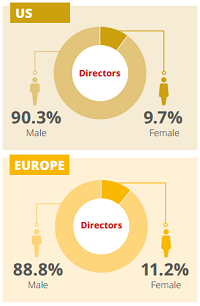 |
| The boardrooms of small and mid-size biotechs are overwhelmingly male.--Courtesy of Liftstream |
The average board of directors in the biotech world is roughly 90% male, according to a new analysis, and more than half of all industry boardrooms host no women whatsoever, striking numbers that illustrate a sector that struggles with diversity.
Liftstream, a recruitment services outfit, analyzed nearly 1,150 life sciences companies in the U.S. and EU, finding that biotech's boardrooms tend toward Y chromosomes. Among drug developers with fewer than 1,000 workers, women held just 10% of available board seats, and fewer than 4% had female chairs. C-suites didn't fare much better, as women accounted for fewer than 25% of leadership teams across the industry.
As for Big Biotech--defined by Liftstream as companies with 1,000 or more employees--women accounted for about 19% of all boards, twice the proportion of small caps, but occupied just 15% of functional leadership roles.
And the problem, as the report illustrates, is not a matter of ambition. Of 530 biopharma leaders surveyed by Liftstream, roughly the same proportion of men and women said getting on a board was a personal goal. But 59.4% of male respondents said they'd been contacted about such positions in the past two years compared with just 16% of their female counterparts, a difference that meets the threshold for statistical significance.
The issue, in part, is biotech's insularity. Many companies, especially in the under-1,000 group, have unstructured hiring processes and rely too heavily on personal networks, according to Liftstream. That leads to something of a confirmation bias: If you know only male executives, you may consider only males for executive positions.
"Gender equality is not going to happen without men getting more involved in the discussion," Sanofi Executive Vice President Pascale Witz told Liftstream. "Often men don't understand the bias that exists and that both sexes perpetuate. Men should be more engaged in working out how that bias is expressed."
One way out of that trap is the establishment of diversity-encouraging initiatives, according to the report, which highlights some case studies of such efforts from Merck KGaA, Cubist ($CBST), Johnson & Johnson ($JNJ) and Biogen Idec ($BIIB).
And the current numbers, while far from equal, illustrate the path to progress, survey respondents said. There's a well-defined path to the boardroom that begins in functional leadership, and the growing number of women in biotech's C-suite suggests that, with the right talent-identification protocols in place, the next generations of directors will better resemble the population at large.
"The key issue is having enough women CEOs and CxOs available for the (non-executive director) pool," Celgene ($CELG) board member Richard Barker told Liftstream. "Once that has been established, talented women will be cross-referred."
- download the report
Special Reports: Top women in biotech 2014